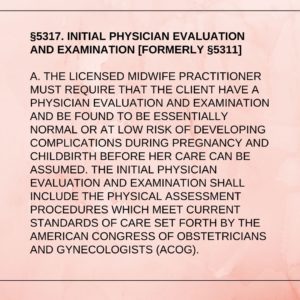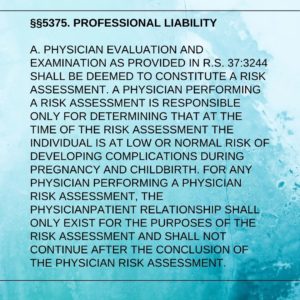Why?
Midwives offer the same tests and ultrasounds along the same timelines as obstetricians. Midwives are trained to perform physical examinations, including pelvic exams, and perform the same ongoing risk assessments during the course of pregnancy. In most states where home birth midwifery is legal, the client never needs to see a doctor at all. Why is it that the client in Louisiana needs to see an OB before they can start their care with a midwife?

Some history…
Louisiana was one of the first states in the US to legalize home birth midwifery during the ’80s. The concept of out of hospital birth was new to the medical community, and the initial joint attempts by the Louisiana Board of Medical Examiners and midwives was to create an atmosphere of collaboration. All home birth clients were to be screened by a physician at the beginning of pregnancy to show they were low to normal risk for pregnancy complications, and again at 36 weeks to show they were low to normal risk for out of hospital birth. Arkansas produced similar rules for their midwives when midwifery became a legal there in the ’90s.
What could go wrong?
There was a problem, though. OBs did not want to perform these evaluations. Some admitted they were afraid of litigation in the event something went wrong. Most felt that the hospital was the best place to give birth and would not have any part otherwise. This was especially a problem for clients trying to get seen at 36 weeks. Doctors were suspicious of what looked like someone going without care until late in pregnancy (which was not the case). I have seen medical records of healthy women, who were in fact low risk, be given a high risk diagnosis after they confided to their doctor their desire for a home birth. It created a culture of distrust and secrecy all around.
Ch ch ch changes
With the financial backing of the Louisiana Midwives Association, the Louisiana Midwifery Rules and Regulations were amended in 2016, over 30 years later. We were unable to eliminate the initial evaluation at the beginning of pregnancy, but we were able to remove the requirement for the 36 week screen, and were able to add a part protecting the physician from any liability from a client who receives midwifery care after their assessment.

It is written…
Presently, a pregnant person needs to see an obstetrician before they can began care with a midwife is because of an antiquated law. This law undermines the client’s ability to have a voice in their care because if they exercise their right to decline this initial OB assessment, their midwife is prohibited from initiating care. However, one positive from this particular Rule is that a relationship is established between the client and doctor, so the client can be seen in a timely manner in the event the midwife discovers a condition necessitating the doctor’s expertise.


